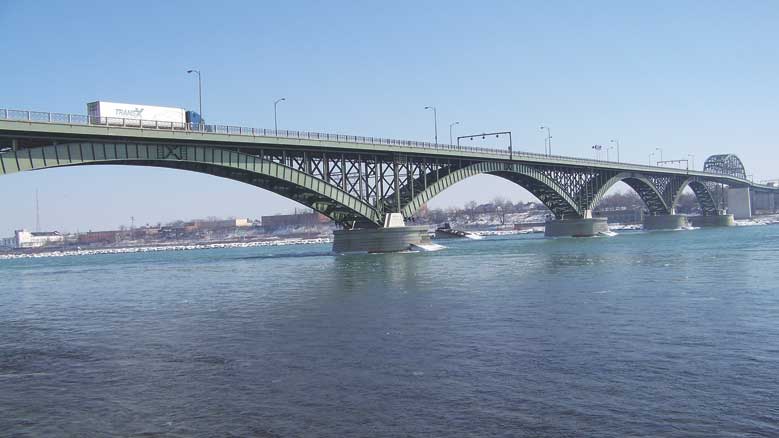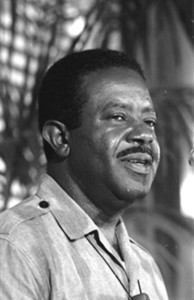
The most distinctly Quaker form of political action is the silent vigil. I have always contended that demonstrations should be meetings for worship with a concern for peace and justice. When a few stood in front of the White House, night and day, for three months in 1971, holding blank white placards that symbolized silent worship, there was only one sign, saying “Quaker Vigil for Peace.” The message, explained by the leaflets handed out to passersby, got across.
In 1965, a family from New York Yearly Meeting stood in a circle of about 15 demonstrators, mostly African American, in front of some church doors in Jackson, Mississippi. The family had been attending this church for several weeks, working quietly inside for integration, an issue hotly debated by the members of the church that year. The Quakers hadn’t intended to be part of the demonstration, but when they saw what was happening they decided to stay outside the doors if the others were not let through them. Some of these people from Mississippi, black and white, had been trying for two years to break down the wall of segregation that kept them out of this particular church, the largest and most liberal Methodist church in Mississippi. A few months earlier when they had attempted to get in, they had been arrested. Now, tempers were thin and someone started rattling all the locked doors and shouting, “Let us in!” Another tried in vain to sneak in by a side door behind two white blockers. Then, as the processional hymn started inside, the leader got things under control and formed the demonstrators in a circle at the bottom of the long flight of stone steps. “Come down and join us,” he said to the Quakers. “If we come down there, we can’t be a bridge between you and the church any more; if you come up here, we can all stand together,” was the reply. So the demonstrators came up, to make a circle, directly in front of the main door. The leader knelt for a while, but silent prayer was maintained by the group for the full hour. The church ushers blocking the door had no choice but to be in the circle. The head usher, a well-known doctor, chomped on his fading cigar during what must have been the largest silent meeting for worship in the history of Mississippi. Afterwards, this usher made a comment that indicated a softening of attitude. An hour earlier the situation had seemed ripe for police intervention and another mass arrest. One month later the church, which had lost a pastor and ten percent of its members over the issue, voted voluntarily to integrate. It was a breaking of the wall, and it swiftly led to other such integrations.
Too often we read the word “demonstrate” as if it were “remonstrate.” The word “demonstrate” should mean “to show the way by example.” The demonstrator can influence only by contagion, and without inner peace cannot spread peace. God works in people, and what a person is will be apparent, no matter what words are written on the banners.
My son said to me, when he was 13, that he didn’t believe in peace demonstrations sometimes. “How so?” I said. “You went on the Easter pilgrimage to Canada, and that was a peace demonstration.” “Oh, but that was different,” he said. “That was really doing something.”
Precisely.
On Easter morning, 1967, almost 300 of us—Quakers, pacifists, and antiwar people—stood by the Peace Bridge between Buffalo, New York, and Fort Erie, Canada, having kept vigil most of the night in shifts. Our purpose was to take money across to Canadian Friends. It was a deliberate and prayerful challenge to the U. S. Treasury Department’s ban on medical aid to victims of U.S. bombing in Vietnam. Canadian Friends would take our money and, as they had been doing for some time, use it to ship medical supplies to both North and South Vietnam. That same Easter morning, the ship Phoenix was nearing Haiphong, Vietnam, with a cargo of medicine sent by A Quaker Action Group. Because the U. S. government had frozen the AQAG bank account and had even started blocking checks to the Canadian Friends Service Committee, we were going ourselves, with cash. At the narrow gateway to the Peace Bridge, Treasury Department officials, notified in advance, were waiting to warn us, one by one, of a possible ten years in jail.
At 6:00 a.m. it was gray, not yet dawn, and cloudy. We were standing in a circle as we gathered, and someone suggested, “Let’s open the circle toward the sunrise,” and we did. It was a rich meeting of half an hour with much vocal ministry that was deeply felt, and towards the end came these words:
Open eastward toward the sunrise,
Let your faces catch the flame.
When the clenched heart cracks and opens,
It is morning, come again.
A few seconds later, the sun rose and unexpectedly broke through the clouds; the gray night turned to fire. It had been cold all spring and we had shivered that night, but before the morning was half over coats were shed. It was the first real day of spring, and all of us, I think, felt it as a reality, a symbol incarnate. When we learned later about the Phoenix’s touching land at Haiphong at almost the same time, allowing for the time change, as our own dawn, I think some of us felt a superstitious wonder at the coincidence, and at the ship’s name.
But these were externals. What was important to us was the tenderness, the dread, and the joy, all mingled, as we gathered after breakfast in what we called The Lower Room, just before going over the bridge. We had to mop the flood water off the floor before we could get in. Then there was silence and speaking, and a Canadian girl spontaneously sang a folk song, plaintive and beautiful. There were tears standing unshed in the eyes of people who wanted to speak because they had so much to say but who couldn’t trust their voices to say it for them. For most of us this was our first experience in civil disobedience. We wondered whether the government would stop us, confiscate our money, or arrest us. For me, one fear was that I would, as one of the leaders, get my name or my picture in the newspapers and would thereby lose my teaching job. (The story did get in my hometown paper, and I didn’t lose my job.) It was just before that meeting that I told the other leaders that I had decided to come out from my safe position in the rear and go over the bridge with the first group of four. I did not tell them that it was the thing I was most afraid of. It was a deep breath and over the waterfall. And that was what made all the difference. The sense of wonder and warmth that came then, and sometimes since, could be reached only by walking. As poet Theodore Roethke says, we learn by going where we have to go.
When our leader, Ross Flanagan, the last person to go over the bridge, came back successfully—having taken actual medical supplies, not just money, and therefore having run into obstacles and threats greater than the rest of us—he turned to some of us, his face glowing, and said, simply, “The Lord is risen.” In that rich moment, when all things seemed possible, there wasn’t a one of us there who doubted.

The next year, 1968, brought the assassination of Martin Luther King Jr. and the Poor People’s Campaign. In June, three days after 100,000 people gathered at the Lincoln Memorial, Ralph Abernathy told a group who had kept vigil all night at the Department of Agriculture that he had made a mistake in allowing so much of the movement’s energies to be drained away by the big spectacle of the mass demonstration; henceforth he would cast his lot with those who were ready to go to jail with him. Three days later almost 500 went. On the first prison bus in front of the Capitol to be filled, Ralph Abernathy blessed a cup of water that someone provided, and it was handed around. There wasn’t much. One man grasped the cup greedily as if to drink it down, but when I told him that Ralph Abernathy had blessed the water he paused; his face softened, and he took just a little sip. There was a hush of silent communion that even words did not dissipate. Later, on the many transfers by bus from one prison to another, the singing and chanting started. One man, perhaps the toughest, least saintly among us, stood in the center aisle and led the chanting. He stamped out the words with his feet, his hands, his whole body. We all stamped and shouted with him. The bus shook, and the ground shook, and the blacks on the streets as we rolled by nearly all smiled and waved, many with the V-salute or the fist, and I thought that this time the walls of injustice must surely come tumbling down. They didn’t, of course. It takes much more than ecstasy and singing to work fundamental social change.
Still, a month later a senator’s legislative assistant and a congressman told me that the Poor People’s Campaign, while not achieving its goals, was having a much bigger impact on Congress than could be guessed from the largely hostile comments in the press—or even from the discouraged private comments of the movement’s own leaders.
That was many years ago, and I cannot even remember the words we chanted. I cannot remember the jokes Dick Gregory and Andy Young made in the packed church in Selma the night before the 1965 march. I can only remember the hilarity, the laughter, and then the swaying people, the swaying church, and the warm hands and crossed arms when we sang “We Shall Overcome.” Four years later I heard Dick Gregory again before an even larger audience of college students in New Paltz, New York. The message still crackled, the jokes were still sharp, the laughter was still strong, and the audience was with him. But it was not the same. This time we were spectators, not participants. We were sympathizers, but we were not committed. There was no scent of danger in the air, and Martin Luther King was dead. We knew that we would not be moving out to march in the morning. There was spirit but no body. There was no incarnation, no transubstantiation, no Being There. And that was what made all the difference.



Comments on Friendsjournal.org may be used in the Forum of the print magazine and may be edited for length and clarity.